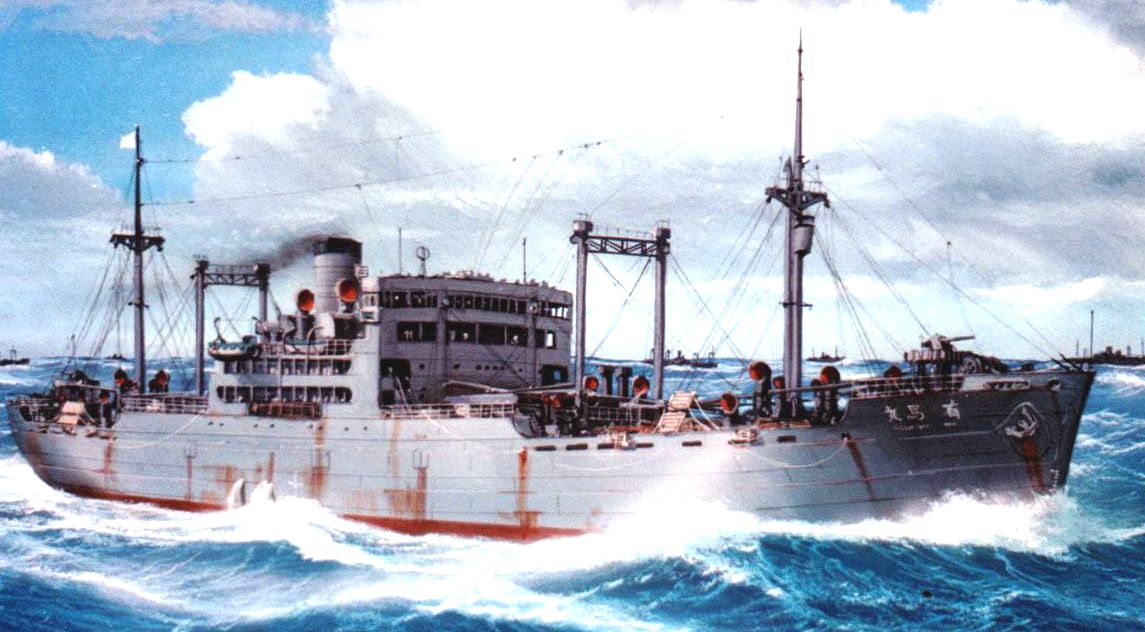YUSOSEN!

|
(Arima Maru by Ueda Kihachiro)
IJN ARIMA MARU:
Tabular Record of Movement
© 2009-2021 Bob Hackett and Peter Cundall.
Revision 1
18 March 1936:
Nagasaki. Laid down at Mitsubishi Jukogyo K.K. Nagasaki Zosensho as a 7,389-ton passenger/cargo ship for the Nippon Yusen K. K. (NYK) Line.
10 September 1936:
Launched and named ARIMA MARU.
30 November 1936:
Completed and registered at Tokyo with Gross Registered Tonnage (GRT) and Net Registered Tonnage (NRT) of respectively 7,386-tons and 4,327-tons. Her Call sign is JIZK. [1]
1937:
In sevice on NYK’s eastbound round the world route.
1938:
Her GRT and NRT are changed respectively to 7,389-tons and 4,326-tons. [1]
14 May 1941:
Departs Antofagasta, Chile.
25 May 1941:
4 miles S of Mollendo harbor, Peru, runs aground on a shoal. Later, NYK’s TAKAOKA MARU commences salvage work.
24 September 1941:
Refloated. Taken in tow by NYK’s SAKITO MARU. Arrives at Callao, Peru, for makeshift repairs.
9 October 1941:
Departs Callao, still in tow by SAKITO MARU.
20 November 1941:
Arrives at Yokohama for 8-month repairs.
11 March 1942:
At 2300 in 31-52N 131-49E attacked by an enemy submarine. Subchaser CH-13 is instructed to search for and sink the submarine.
6 July 1942:
Requisitioned and commissioned in the IJA as a transport ship. Merchant Captain Taguchi Suguru is appointed Supervisor.
3 October 1942:
In IJA service as a dispatch vessel under Deputy Minister of Communications Sea instruction No. 1582.
31 October 1942:
Departs Nagoya for Saigon, French Indochina (now Ho Chi Minh City, Vietnam).
November 1942:
Operates as an IJA transport.
10 December 1942:
Her owners receive a requisition notice under Armed Forces message No. 17-11-21.
29 December 1942:
Released to her owners and requisitioned again that same day by the IJN.
Navy (Resv) Taguchi Hidekazu is appointed Commanding Officer.
30 December 1942:
Osaka. Enters drydock at Innoshima shipyard. Begins conversion to a secondary emergency oiler (tanker).
15 February 1943:
Registered in the Kure Naval District as a specially installed transport ship (oil supply under Ordinance No. 255). Assigned to the Navy department as a Ko category auxiliary transport. The CO of ammunition ship ONOE MARU, Captain Ozawa Satoru, is appointed Supervisor as an additional duty. [2]
28 January 1943:
Implement a heavy oil replenishment device as soon as possible under Instruction No. 281830.
20 February 1943:
The conversion is completed.
3 March 1943:
Departs Kure.
11 March 1943:
Arrives at Singapore. Loads 7, 880 tons of heavy oil, gasoline and takes three gun boats aboard.
March 1943:
Departs Singapore for Balikpapan, Borneo, Netherlands East Indies (now Kalimantan, Indonesia).
25 March 1943:
An unknown submarine attacks ARIMA MARU, but she evades its torpedoes.
28 March 1943:
Arrives at Balikpapan. Lands the three gun boats.
30 March 1943:
Departs Balikpapan for Truk, Carolines.
3 April 1943:
N of Palau. Destroyer YUZUKI joins ARIMA MARU as her sole escort.
Later that day N of Palau LtCdr (later Rear Admiral) Roy M. Davenport’s USS HADDOCK (SS-231) sights a large passenger/cargo ship at 19,000 yards that is misidentified as of the 11, 930–ton YASUKUNI MARU-class. USS HADDOCK, running on the surface, tracks the ship for five hours and finally pulls ahead. As the grey-painted ship nears, USS HADDOCK’s crew spots an escort to starboard that they misidentify as a "corvette".
At 1255 (I), Davenport fires a stern torpedo at the destroyer and three stern torpedoes at ARIMA MARU. The torpedo runs too deep and misses the destroyer, but the other three hit and stop the big ship. Davenport sees her on fire and down by the bow, but then the destroyer counterattacks.
As depth charges fall, Davenport takes USS HADDOCK deep – too deep! At about 415 feet, far below test depth, her conning tower begins to deform. Davenport evacuates the conning tower, evades the destroyer, then makes for Pearl Harbor. YUZUKI rescues survivors from sinking ARIMA MARU.
4 April 1943:
ARIMA MARU sinks at 10-12N, 134-35E.
1 May 1943:
Removed from the Navy List.
Authors' Notes:
[1] NRT is a ship's cargo volume capacity expressed in "register tons", one of which equals to a volume of 100 cubic feet (2.83 m3). It is calculated by subtracting non-revenue-earning spaces i.e. spaces not available for carrying cargo, for example engine rooms, fuel tanks and crew quarters, from the ship's gross register tonnage (GRT). Net register tonnage (NRT) is not a measure of the weight of the ship or its cargo, and should not be confused with terms such as deadweight tonnage or displacement.
[2] There were two categories of Yusosen. The Ko category with an IJN Captain as supervisor aboard and the Otsu category without.
Thanks for assistance goes to Sander Kingsepp of Estonia and Berend van der Wal of Netherlands. Thanks also go to Gengoro S. Toda of Japan.
- Bob Hackett and Peter Cundall.
Back to the
Oilers Page





